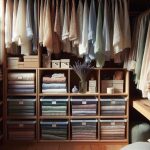When you store fabrics, how do you make sure they remain in pristine condition? It's crucial to control the climate, maintaining temperature and humidity stable, ideally between 65-75°F and 45-55% humidity. Choosing the right storage space and using breathable containers are just the beginning. You also need to think about using acid-free tissue paper and avoiding plastic containers to prevent any damage. But what about the best ways to fold or roll different types of fabrics, and how can you shield them from pests and sunlight? There's much more to take into account to keep your fabrics looking their best.
Table of Contents
Key Takeaways
- Store fabrics in breathable containers to allow air circulation and prevent moisture buildup.
- Use acid-free tissue paper between folds to prevent creases and discoloration.
- Maintain stable temperature (65-75°F) and humidity levels (45-55%) to protect fabrics.
- Keep fabrics in dark, cool places away from sunlight to prevent fading and damage.
- Regularly inspect fabrics for pests, moisture, and signs of damage to ensure preservation.
Choose the Right Storage Space
Choosing the right storage space is vital to avoid fabric damage. You need to prioritize climate control and fabric protection to maintain the quality of your textiles. Temperature and humidity play significant roles in fabric preservation.
A climate-controlled environment prevents mold, mildew, and pests, which can wreak havoc on your valuable fabrics. Aim for a stable temperature around 65-75°F and humidity levels between 45-55%.
Next, consider space organization. Proper storage solutions can make a world of difference. Opt for shelving units that allow air circulation, as fabrics need to breathe. Use acid-free tissue paper and cotton storage bags to further safeguard your textiles from dust and light exposure.
Clear, labeled bins can help you organize your fabrics by type, color, or project, making it easier to find what you need without rummaging through piles.
Investing in high-quality storage solutions will pay off in the long run. Under-bed storage boxes, hanging racks, and dedicated fabric drawers are excellent options. Keep your storage area clean and dry, and regularly inspect your fabrics for any signs of damage.
With these strategies, you'll guarantee your fabrics stay pristine and ready for use.
Clean Fabrics Before Storing
Before placing your fabrics in their designated storage spaces, make sure they're thoroughly cleaned to prevent any lingering dirt or stains from causing long-term damage. Dirt and oils can attract pests, which can ruin your fabrics, while stains can become set-in, making them nearly impossible to remove later. Washing your fabrics properly will help prevent mold growth, as damp or dirty materials are prime breeding grounds for mold and mildew.
To begin, sort your fabrics by type and color to avoid any color bleeding or fabric damage during the cleaning process. Use a gentle, fabric-appropriate detergent and verify each piece is completely dry before storing. This step is essential because even a small amount of moisture can lead to mold and unpleasant odors, undermining your efforts to maintain freshness.
For delicate fabrics, consider hand washing or using a mesh bag in the washing machine on a delicate cycle. After washing, air dry your fabrics in a well-ventilated area, preferably away from direct sunlight to avoid fading.
Ensuring your fabrics are impeccably clean and dry before storage will go a long way in preserving their quality and longevity.
Use Acid-Free Tissue Paper
Acid-free tissue paper is crucial for safeguarding your fabrics from discoloration and deterioration over time. By using this specialized paper, you create a buffer that protects against harmful acids that can seep from regular paper or cardboard.
To guarantee your fabrics remain in excellent condition, you'll want to master the art of proper folding techniques. Start by laying out your fabric on a clean, flat surface. Place a sheet of acid-free tissue paper on the fabric, and begin folding it gently. Make sure to insert additional sheets of tissue paper between each fold. This prevents creases from forming and provides extra protection against potential damage.
Avoid sharp folds; instead, aim for soft, rounded ones to minimize stress on the fibers. For particularly delicate or valuable items, consider wrapping the entire piece in acid-free tissue paper before folding. This adds an additional layer of defense, preserving the fabric's integrity.
When storing, place the folded fabric in a dry, dark location to further shield it from environmental factors.
Avoid Plastic Containers
While plastic containers might seem like a convenient storage solution, they can actually trap moisture and cause mildew or mold to develop on your fabrics. This moisture retention can lead to irreversible damage, compromising both the fabric's integrity and appearance. To ensure optimal fabric preservation, you should opt for breathable containers that allow air circulation.
Fabric bins are an excellent alternative. These storage solutions not only provide the necessary air flow to prevent moisture buildup but also protect your fabrics from dust and pests. By using fabric bins, you can maintain the quality and longevity of your textiles, ensuring they remain in pristine condition for years to come.
Additionally, consider the environmental impact of your storage choices. Plastic containers contribute to environmental pollution and take centuries to decompose. By choosing breathable containers made from sustainable materials, you're not only preserving your fabrics but also making a positive impact on the environment.
Mastering fabric preservation involves understanding the importance of proper storage solutions. Avoiding plastic containers and opting for breathable, eco-friendly alternatives will help you maintain the quality of your fabrics and contribute to a healthier planet.
Roll, Don't Fold
Switching to breathable storage containers is a great start, but how you store your fabrics also matters—rolling them instead of folding can prevent creases and damage. Mastering this technique enhances both fabric care and space saving in your storage areas.
Rolling your fabrics minimizes the pressure points that lead to permanent creases and weak spots, ensuring your materials remain in pristine condition.
To perfect your fabric organization, follow these steps:
- Prepare the Fabric: Lay your fabric flat and smooth out any wrinkles. If necessary, lightly iron to remove stubborn creases before rolling.
- Roll Strategically: Start at one end and roll the fabric tightly, but not too tight to avoid stretching. This method distributes tension evenly, preventing damage.
- Store Properly: Place rolled fabrics in breathable containers or on shelves, ensuring they're not stacked too high, which could exert pressure and cause distortion.
Implementing these preservation tips will extend the lifespan of your fabrics. By taking these steps, you'll not only enhance your fabric care routine but also achieve a more efficient and organized storage system.
Embrace rolling as a superior method for both preservation and space saving.
Maintain Optimal Humidity
To keep your fabrics in top condition, you need to maintain the right humidity levels. Aim for a relative humidity of around 50% to prevent mold and mildew.
Use moisture control strategies like dehumidifiers or silica gel packs to achieve this balance.
Ideal Humidity Levels
Maintaining an optimal humidity level of about 50% is crucial to prevent fabrics from becoming brittle or developing mold. Proper humidity management is a key aspect of fabric preservation.
If the air is too dry, your fabrics can lose their natural flexibility and strength, making them more prone to tears. Conversely, excessive humidity can lead to mold growth, which not only harms the fabric but also poses health risks.
To excel in the art of fabric preservation, follow these key guidelines:
- Invest in a Hygrometer: Use this tool to monitor the humidity levels in your storage space. Maintaining consistent readings around 50% will help you find the perfect balance.
- Climate-Controlled Storage: If possible, store your fabrics in a climate-controlled setting. This guarantees that temperature and humidity levels remain stable, reducing the risk of damage.
- Avoid Basements and Attics: These areas tend to have fluctuating humidity levels, making them unsuitable for fabric storage. Opt for interior rooms that maintain a more stable environment.
Moisture Control Strategies
Managing moisture levels effectively guarantees your fabrics stay in impeccable condition over time. Start by placing a dehumidifier in the storage area. This device is vital for maintaining ideal humidity, which should ideally be between 30% and 50%. A dehumidifier not only keeps the air dry but also actively prevents mold from taking hold. Mold prevention is essential, as mold can cause irreparable damage to your stored fabrics, leading to discoloration and decay.
Monitor the humidity levels regularly using a hygrometer. This small investment guarantees you're always aware of the conditions in your storage area. If you notice the humidity creeping above the desired range, adjust your dehumidifier settings immediately. Remember, fabrics like cotton and linen are especially prone to moisture, so vigilance is crucial.
In addition to dehumidifier usage, consider using silica gel packets in your storage containers. These packets absorb excess moisture, providing an extra layer of protection. Ensure that your storage space is well-ventilated to facilitate air circulation, further aiding in mold prevention.
Protect From Direct Sunlight
Direct sunlight can cause fabrics to fade and weaken over time. To maintain the integrity of your textiles, you need to implement effective sunlight protection strategies. Start by storing your fabrics in dark, cool areas where sunlight can't reach them. This simple step will go a long way in preserving their vibrancy and strength.
Next, consider fabric rotation. Rotate your stored fabrics periodically to guarantee even light exposure levels. By doing this, you prevent one piece from bearing the brunt of any latent sunlight that might filter through. It also helps you keep track of your collection and maintain its condition.
Utilize fabric swatches to test areas for light exposure. Attach small swatches of similar fabric in different parts of the storage area and inspect them periodically. This will help you understand how much light each section gets and adjust your storage accordingly.
Here's a quick checklist to guide you:
- Store fabrics in dark, cool places: Keep them away from windows and direct sunlight.
- Rotate your fabrics regularly: Helps in distributing light exposure evenly.
- Use fabric swatches as indicators: Monitor light exposure levels effectively.
Keep Away From Pests
While shielding your fabrics from sunlight is important, keeping them safe from pests is equally essential. Pests like moths and silverfish can wreak havoc on your cherished textiles, causing irreparable fabric damage.
To guarantee effective pest prevention, start by thoroughly cleaning your fabrics before storage. Even the slightest food residue or body oils can attract unwanted guests.
Opt for airtight storage solutions like plastic bins or vacuum-sealed bags. These not only keep pests out but also provide a barrier against moisture, which can invite mold and mildew.
For added moth protection, invest in natural repellents like cedar blocks or lavender sachets. These not only deter pests but also leave your fabrics smelling fresh.
Regularly inspect your storage area for signs of pests. Look for tiny holes in fabrics, larval casings, or droppings. If you notice any, act quickly by cleaning the affected area and laundering the fabrics.
Avoid using mothballs, as they contain chemicals that can be harmful to both your fabrics and your health.
Store by Fabric Type
When storing fabrics, you've got to take into account the specific needs of each type. Natural fibers like cotton and wool require breathable storage, while synthetic fabrics benefit from airtight containers to prevent moisture damage.
Natural Fibers Care
For best preservation, store natural fibers like cotton, linen, and wool in a cool, dry place away from direct sunlight. Use these fiber preservation techniques to safeguard your fabrics remain in top condition.
Cotton and linen benefit from breathable storage solutions such as cotton bags or acid-free tissue paper. Wool, being more susceptible to pests, requires additional care.
When dealing with seasonal storage solutions, make sure your items are clean before storing them. Dirt and oils attract pests and can degrade fibers over time.
For vintage fabric care, consider using acid-free tissue paper to wrap each piece, preventing yellowing and creases.
To protect wool and other susceptible fibers, follow these moth prevention tips:
- Clean Thoroughly: Wash or dry-clean your fabrics before storage to remove any larvae or eggs.
- Use Cedar or Lavender: These natural repellents can keep moths at bay without the harsh chemicals found in mothballs.
- Seal Properly: Store your fabrics in airtight containers to prevent moths and other pests from getting in.
Synthetic Fabrics Storage
Have you ever wondered how to properly store synthetic fabrics like polyester, nylon, and acrylic to ensure they remain in impeccable condition? The secret lies in understanding fabric preservation and implementing effective temperature control.
Start by ensuring your storage area is cool, dry, and away from direct sunlight. Excessive heat and humidity can weaken synthetic materials, compromising their longevity.
Next, consider using breathable garment bags or containers. Avoid plastic bags, as they can trap moisture, leading to mildew. Instead, opt for cotton or linen coverings that allow air circulation, which is crucial for fabric longevity. Also, keep items off the floor where they're vulnerable to dust and pests. Shelves or elevated storage solutions work best.
When folding synthetic fabrics, avoid sharp creases by using acid-free tissue paper. This prevents permanent marks and maintains the fabric's structure.
For items like dresses or suits, padded hangers provide better support and prevent stretching.
Regularly Inspect Stored Fabrics
Regular examinations of your stored fabrics can help you detect early signs of damage, safeguarding they remain in good condition. To master fabric preservation, you need to integrate fabric rotation and storage organization into your routine. By doing so, you'll prevent issues like mildew, fading, and pest infestations that can compromise fabric quality.
Start by setting a regular schedule for inspections, ideally every three to six months. During these inspections, pay close attention to any changes in the fabric's texture, color, or scent.
Here's how you can effectively examine your stored fabrics:
- Check for Pests: Look for signs of moths or other insects. Small holes or shed skins are indicators.
- Examine for Moisture: Feel the fabric for any dampness. Moisture can lead to mold or mildew, which is detrimental to fabric preservation.
- Rotate Fabrics: Rearrange your fabrics to guarantee even exposure to environmental conditions. This simple storage technique helps in maintaining uniform quality.
Frequently Asked Questions
How Long Can Fabrics Be Stored Without Damage?
In the grand scheme of fabric storage duration, you can store fabrics for years if you follow best practices. To prevent fabric damage, keep them in a cool, dry place, and avoid direct sunlight and pests.
What Are the Best Practices for Storing Delicate Fabrics?
To master fabric storage, use proper fabric folding techniques, avoid direct sunlight exposure, and maintain temperature control. Guarantee mold prevention by keeping fabrics dry and clean. These practices will preserve your delicate fabrics impeccably.
Can Scented Sachets Be Used in Fabric Storage?
Imagine your fabrics basking in a garden of scent. Yes, scented sachets can be effective for fabric storage, but guarantee moisture control. Alternatives like cedar blocks also work wonders to keep your treasures pristine.
How Should Vintage or Antique Fabrics Be Preserved?
To preserve antique textiles and vintage garments, you should use proper preservation methods and restoration techniques. Store them in acid-free boxes, control humidity, and avoid direct sunlight to maintain their integrity and prevent damage.
Are There Special Considerations for Storing Dyed Fabrics?
Think of your dyed fabrics like a vampire avoiding sunlight. To prevent dye fading, control light exposure and keep humidity in check. Proper storage wards off mold growth, ensuring your vibrant textiles remain pristine and beautiful.
- What to Wear With Selvedge Jeans: the Ultimate Styling Companion - June 24, 2025
- How to Identify the Selvedge Edge on Any Fabric - June 24, 2025
- A Weaver’s Guide: What Is a Floating Selvedge and When to Use It - June 24, 2025







